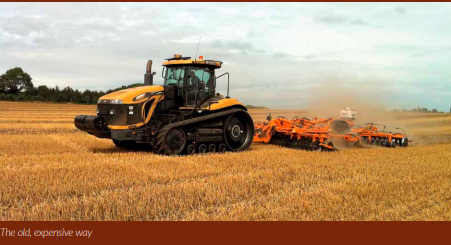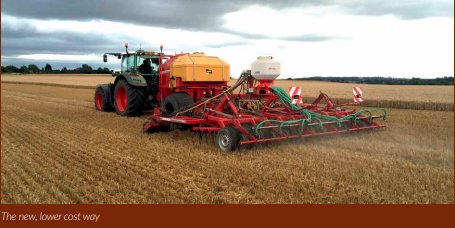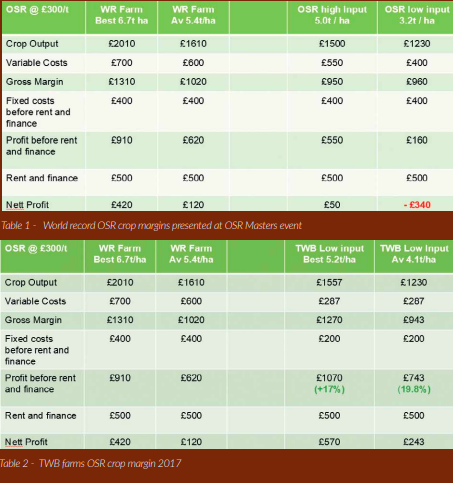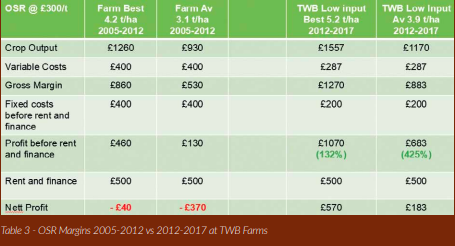The Gross Output hamster wheel

It’s not uncommon to hear no-till farmers talk about the ‘hamster wheel’ of tillage – i.e. that cultivation creates the need for more cultivation. This continues until you jump off the wheel and make changes, including those to your rotation and agronomy, breaking the bond that links tillage to growing successful, consistent crops. There is, however, another and often not so widely considered catch 22 that has become the normal in UK agriculture, and it is a massive barrier for any farmer considering changing their farming system. I’m talking about the need, or even the addiction, to farm for maximum output and gross margin at all costs.
It is something that has slowly but surely turned many UK farms into the financially unsustainable, subsidy dependant businesses that they are today. I don’t think its accidental either. A generation or more of farmers have been sold this gross output myth by those that supply them with inputs and machinery that promise bigger yield or greater efficiency. They fund trials, shows and advertising that always has the same message, “grow more” “do more” “increase output” and you will be better off. As farmers we need to ask ourselves who does this really benefit? The maximum gross output treadmill means management and cropping decisions must be based around generating as much cashflow as possible, rotation must be dominated by high gross margin crops like all autumn planted wheat and rape which also demand early input spend.
Fixed costs should be spread over the largest possible areas, biggest possible machines and lowest possible number of people. Often ridiculous levels of rent or cut-price contract farming deals become justified in such systems as it’s all about spreading costs further and increasing that gross output the business now needs because it has rent to pay and machinery loans to cover. Having as much to sell as possible becomes more important than the cost of achieving that output. Many farms seem to have lost sight of costs, and the profit they make before subsidy.

A business can be unprofitable for years and still survive, especially if like many farm businesses it has the ability to borrow money. However any business will only ever run out of cash once and that’s the day the farm sale signs get put up. This is the trap than many now find themselves in, where cashflow is more important than profit, yet surely long term ignoring profitability creates a somewhat fundamental problem and the hole being dug though increasing borrowings simply gets deeper. Gross output of a business and gross margin of crops shouldn’t be confused. “Yield is king” is an often-heard mantra and one that is to a great extent very true.
If you are committed to grow a crop you need to maximise its gross margin and any input that offers a margin over its cost is justifiable and surely the right thing to do. I have never thought of zerotill / conservation agriculture as a lower gross margin system, and I still farm fairly conventionally in terms of variety and crop protection product choice, and my aim is to get the best yield my soils are realistically capable of every year. Anything that can prove a MOIC is used here, it is not about low input producing low outputs of individual crops as is often assumed, but the aim in my system is always maximum margin.

So much focus is placed on variable costs and crop gross margins yet debating the pro’s and cons of one fungicide vs another as farmers often do is neither here nor there in the bigger picture and is really tinkering while Rome burns. Making a few inputs savings is unlikely to transform many farm business fortunes. But just maybe a radical restructure of the fixed costs might be the way to finally jump off that gross output hamster wheel? Many assume moving to zero tillage will bring significant inroads into the structure of fixed costs.
Yet it’s not as simple as dashing out and buying a shiny no-till drill. In fact in isolation that’s probably just going to make things worse! Farmers often don’t need much of an excuse to jump on the latest trend if it involves new machinery but in zero-till the drill is one of the last pieces of a complex jigsaw that needs consideration. Change starts with rotation, the cornerstone of any successful zero-till farming system. Less autumn cropping of high output crops like Rape and Wheat will usually mean a drop in farm output – but this shifting of work away from the bottle-neck of autumn to a more even spread of field work between harvest and spring will make a serious reduction in the amount of power, machinery and people required to get the work done. It can double the area you can cover with existing resources, or halve the size (and cost) of what you have. Either way the fixed costs per acre will fall dramatically as a result. Spring crops tend to be far less input hungry and use less nitrogen.
Their output is lower, but growing costs are also much smaller and the length of time your cash is out in the field vs in the bank is shorter as well. Agronomically they bring an opportunity to use different spectrum and timings of herbicides helping with potential resistance and grassweed issues. It also creates a chance for over winter cover crops to be grown, capturing sunlight, water and nutrition that might otherwise be wastefully disappearing down your drains whilst feeding essential soil biology and building soil organic matter levels. The value of these things is not only financial but also environmental, the habitat it creates for wildlife is obvious as are the bigger issues such as carbon capture and a reduction in soil erosion and water pollution etc. It seems that the government and environmental lobbies are increasingly aware that farmers are in the best position to improve this situation, so it could well form the foundation of future support schemes.
This return to a “proper” rotation is the big important first step to increasing soil health and dependency on bags and bottles which leads to better yields at lower costs. But more significantly it’s the key to the reduced power, labour and mechanisation that are involved in zero- till vs tillage systems.

Looking at my own farm and accounts when we ran a min-till system we were using 32L/ha of fuel at establishment, today that figure is 4L /ha – 32L is what we now use from stubble to stubble! Labour has halved from 1 man /1000ac to 1 man /2000ac, wearing metal costs are almost insignificant vs their historic levels and most importantly of all the capital tied up in machinery has more than halved as well. This has removed a huge amount of depreciation and finance from our accounts and freed up capital for other investment. My costs have fallen dramatically, my gross margins are improved as we grow better higher yielding crops these days. However the lower output spring crops have reduced gross output, but with far lower costs to finance I’m far less dependent on cash flow and far freer to focus on maximising profit.
I am watching the ADAS YEN program with great interest and am in awe of the yields some achieve, they push boundaries to new levels and break world records along the way in some cases. To me its farming’s equivalent of watching a drag racing car, an impressive sight but not really something you want to be doing yourself unless you have very deep pockets ! I was recently shown the numbers behind the 2017 OSR world record presented at a “OSR Masters” event (Table 1). They demonstrate perfectly the maximum gross output approach – extraordinary yield yet despite the matching eye-watering variable cost spend, the proof is there of high gross margin. The message is clear, spending pays, and gross output is what successful and profitable farming is all about ………
Or is it! I decided to compare my 2017 OSR crop (table 2) against this shining example of profitable farming (table 2) and the numbers start to question this established wisdom. 2017 was admittedly a very good year for OSR here although it’s not unusual, we see quite respectable yields since our move to zero-till reduced the crop frequency within our now far more diverse rotation. Our highest yield was a barn busting 5.1 t/ha on a 11ac field which included headlands etc (unlike the WR crop rules allow). In stark contrast to the world record crop however this was achieved with a miserly £287/ha of variable costs spend. But yield is clearly king as despite the extra spend the gross margin of the WR crop is the winner here at some £40/ ha better than my best.
This story doesn’t end there however, gross margin is not profit and, once the significantly lower fixed costs of a zero till farm have been covered, the lower output crop is generating nearly 20% more profit! But is this really a fair comparison? My light land, low fertility grade 2/3 soil, midland based farm vs a World beating fertile, heavy land benefiting from longer northern day length and clearly technically very competent farmer? If I decided to play the world record yield game there is no way I could produce those kind of yields no matter what I spent, my soils simply don’t have that in them, so I thought it would be interesting to run some comparisons to my rolling average yields from the last 5 seasons vs the previous 5 seasons (table 3)

This is where things get interesting. It’s clear that using the OSR masters £300/t commodity price and a £500 rent and finance figure for consistency throughout these tables that even my best yields under our old fixed cost structure and variable cost spend was losing money before subsidy. In stark contrast today the lower fixed cost structure and VC spend is generating respectable profit. The business on the right of table 3 is one that is subsidy dependant and, like a desperate gambler at a roulette table, is stuck in a cycle of chasing losses by spinning the wheel again, filling in the gap through borrowing or taking on more land at any cost to try and dilute those fixed costs. The business on the left of that table however is healthy, sustainable, much lower risk, not subsidy dependant, but most importantly…. profitable! www.twbfarms.co.uk
